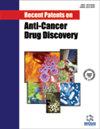Regulating Lipid Metabolism via Mitochondrial Dynamics in Tongue Squamous Cell Carcinoma Cancer Stem Cells
IF 4.1
4区 医学
Q3 ONCOLOGY
Recent patents on anti-cancer drug discovery
Pub Date : 2024-02-02
DOI:10.2174/0115748928275772231226063458
引用次数: 0
Abstract
Background: Cancer stem cells (CSCs) are a sub-population of cancer cells present in many kinds of malignant tumors that have the potential for self-proliferation and differentiation. These cells have been demonstrated as the main cause of tumor recurrence and metastasis. Strong evidence indicates that CSCs prefer reprogrammed fatty acid β-oxidation over oxidative phosphorylation for sustaining energy supply. Although mitochondrial dynamics participate in the regulation of cancer stemness, the correlation between the inhibition of mitochondrial fission and the regulation of lipid metabolism in CSCs remains poorly understood. Methods: The human tongue squamous cell carcinoma (TSCC) cell lines CAL27 and SAS were used to obtain the CSCs by 3D Spheroid Culture. Then,western blot methods, RT-PCR and flow cytometry analysis were used to identify the TSCC CSCs. Next, Immunofluorescence method, transmission electron microscopy detection and western blot methods were used to evaluate the mitochondrial morphology and the quantity of lipid droplets (LDs). Lastly, lipidomic analysis was applied to explored the lipidomic alterations of TSCC CSCs with different mitochondrial morphology. Results: Here, we show that the quantity of lipid droplets containing intracellular triglyceride (TG) can be decreased by regulating mitochondrial morphology. Lipidomic analysis using ultraperformance liquid chromatography-mass spectrometry (UPLC-MS) also compared alterations in lipid metabolites in tongue squamous cell carcinoma (TSCC) CSCs, TSCC cells (non-CSCs), and CSCs with different mitochondrial morphology. Discriminant lipids of statistical significance were successfully annotated, including phosphatidylcholines (PCs), phosphatidylethanolamines (PEs), sphingomyelins (SMs), triacylglycerols (TGs), phosphatidylglycerols (PGs), phosphatidylserines (PSs), lysophosphatidylcholines (LPCs), and lysophosphatidylethanolamines (LPEs). Conclusion: This study provides a deeper insight into the alterations of lipid metabolism associated with TSCC CSCs, non-CSCs and CSCs regulated by mitochondrial dynamics and thus serves as a guide toward novel targeted therapies.通过线粒体动力学调控舌鳞状细胞癌癌症干细胞的脂质代谢
背景:癌症干细胞(CSCs)是存在于多种恶性肿瘤中的癌细胞亚群,具有自我增殖和分化的潜能。这些细胞已被证实是肿瘤复发和转移的主要原因。有确凿证据表明,CSCs 在维持能量供应方面更喜欢重编程脂肪酸β氧化,而不是氧化磷酸化。虽然线粒体动力学参与了癌症干性的调控,但对线粒体裂变的抑制与 CSCs 脂质代谢调控之间的相关性仍知之甚少。研究方法以人舌鳞状细胞癌细胞系 CAL27 和 SAS 为研究对象,通过三维球形培养获得 CSCs。然后,使用 Western 印迹法、RT-PCR 和流式细胞术分析来鉴定 TSCC CSCs。然后,采用免疫荧光法、透射电子显微镜检测法和 Western 印迹法评估线粒体形态和脂滴数量。最后,应用脂质组学分析探讨了不同线粒体形态的TSCC CSCs的脂质组学改变。结果我们在这里发现,通过调节线粒体形态可以减少含有细胞内甘油三酯(TG)的脂滴数量。使用超高效液相色谱-质谱法(UPLC-MS)进行的脂质组学分析还比较了舌鳞状细胞癌(TSCC)CSCs、TSCC 细胞(非 CSCs)和线粒体形态不同的 CSCs 中脂质代谢物的变化。成功注释了具有统计学意义的区分脂质,包括磷脂酰胆碱(PCs)、磷脂酰乙醇胺(PEs)、鞘磷脂(SMs)、三酰甘油(TGs)、磷脂酰甘油(PGs)、磷脂酰丝氨酸(PSs)、溶血磷脂酰胆碱(LPCs)和溶血磷脂酰乙醇胺(LPEs)。结论本研究深入揭示了线粒体动力学调控的 TSCC CSCs、非 CSCs 和 CSCs 脂质代谢的改变,从而为新型靶向疗法提供指导。
本文章由计算机程序翻译,如有差异,请以英文原文为准。
求助全文
约1分钟内获得全文
求助全文
来源期刊
CiteScore
4.50
自引率
7.10%
发文量
55
审稿时长
3 months
期刊介绍:
Aims & Scope
Recent Patents on Anti-Cancer Drug Discovery publishes review and research articles that reflect or deal with studies in relation to a patent, application of reported patents in a study, discussion of comparison of results regarding application of a given patent, etc., and also guest edited thematic issues on recent patents in the field of anti-cancer drug discovery e.g. on novel bioactive compounds, analogs, targets & predictive biomarkers & drug efficacy biomarkers. The journal also publishes book reviews of eBooks and books on anti-cancer drug discovery. A selection of important and recent patents on anti-cancer drug discovery is also included in the journal. The journal is essential reading for all researchers involved in anti-cancer drug design and discovery. The journal also covers recent research (where patents have been registered) in fast emerging therapeutic areas/targets & therapeutic agents related to anti-cancer drug discovery.

 求助内容:
求助内容: 应助结果提醒方式:
应助结果提醒方式:


